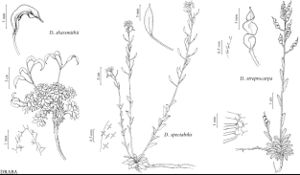Draba sharsmithii
Harvard Pap. Bot. 1(3): 71. 1991.
Perennials; (densely cespitose); caudex branched (covered with persistent leaves or leaf remains, branches sometimes terminating in sterile rosettes); scapose. Stems unbranched, (0.15–)0.3–0.7(–1) dm, glabrous throughout or pubescent proximally, trichomes simple and 2-rayed, 0.1–0.4 mm. Basal leaves rosulate; petiolate; petiole base and margin ciliate, (trichomes simple and 2-rayed, 0.3–1 mm); blade oblanceolate to oblong-obovate or oblong, 0.4–0.7(–1) cm × 1–3(–5) mm, margins entire, surfaces pubescent abaxially with short-stalked, 2–5-rayed trichomes, 0.1–0.4 mm, adaxially glabrous or sparsely pubescent, with simple and short-stalked, 2-rayed trichomes. Cauline leaves 0. Racemes 2–10(–16)-flowered, ebracteate, elongated in fruit; rachis not flexuous, glabrous. Fruiting pedicels ascending, straight, (3–)5–12(–16) mm, glabrous. Flowers: sepals ovate, 2.8–3.5 mm, sparsely pubescent, (trichomes simple and short-stalked, 2–4-rayed); petals yellow, spatulate to oblanceolate, 4–6 × 2–3 mm; anthers oblong, 0.6–0.7 mm. Fruits oblong to lanceolate or narrowly ovate, twisted (curved), flattened, (5–)8–15(–20) × 2–4(–5) mm; valves usually glabrous, rarely pubescent, trichomes simple and short-stalked, 2-rayed, (marginal), 0.5–0.15 mm; ovules 16–20 per ovary; style (0.5–)0.9–1.8(–2) mm. Seeds oblong, 1–1.6 × 0.6–0.7 mm. 2n = 36.
Phenology: Flowering Jul–Aug.
Habitat: Granitic outcrops and rocky slopes in open subalpine conifer communities
Elevation: 3300-3800 m
Discussion
Of conservation concern.
Draba sharsmithii is clearly related to D. cruciata; there is some evidence that it may be an allopolyploid incorporating a genome from that species. It is known only from the vicinity of Mount Whitney in the southern Sierra Nevada (Inyo County).
Selected References
None.

